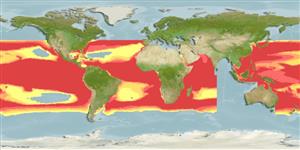Teleostei (teleosts) >
Lampriformes (Velifers, tube-eyes and ribbonfishes) >
Trachipteridae (Ribbonfishes)
Etymology: Desmodema: Greek, desmos = band, chain + Greek, demos = fat, grease, cow fat (Ref. 45335).
More on author: Ogilby.
Environment: milieu / climate zone / depth range / distribution range
Ecology
Marine; bathypelagic; depth range 0 - 500 m (Ref. 58302). Deep-water; 42°N - 52°S, 180°W - 180°E
Western Pacific: Japan, Taiwan (Ref. 5193), Philippines, Australia, New Zealand (Ref. 5755). Eastern Atlantic: 16°11'N (ISH unpublished) to Namibia (Ref. 4506) and South Africa (one specimen washed ashore at Xora River and 1 found in the tide pool at Simonstown, False Bay). Western Atlantic: Florida, USA and Cuba (Ref. 7251). Northern Indian Ocean: 2 records from Pakistan and India (Ref. 93850; Ref. 93851). Probably circumtropical.
Size / Weight / Age
Maturity: Lm ? range ? - ? cm
Max length : 110 cm TL male/unsexed; (Ref. 9137); common length : 100.0 cm SL male/unsexed; (Ref. 47377)
Epi- (Ref. 58302) and mesopelagic species (Ref. 4506). Feeds upon various organisms like small fish, squids, octopus, and crustaceans (Ref. 4525).
Life cycle and mating behavior
Maturity | Reproduction | Spawning | Eggs | Fecundity | Larvae
Heemstra, P.C. and S.X. Kannemeyer, 1986. Trachipteridae. p. 399-402. In M.M. Smith and P.C. Heemstra (eds.) Smiths' sea fishes. Springer-Verlag, Berlin. (Ref. 2713)
IUCN Red List Status (Ref. 130435)
Threat to humans
Harmless
Human uses
Fisheries: commercial
More information
Common namesSynonymsMetabolismPredatorsEcotoxicologyReproductionMaturitySpawningSpawning aggregationFecundityEggsEgg development
ReferencesAquacultureAquaculture profileStrainsGeneticsElectrophoresesHeritabilityDiseasesProcessingNutrientsMass conversion
Tools
Special reports
Download XML
Internet sources
Estimates based on models
Preferred temperature (Ref.
123201): 12.2 - 27.1, mean 19.4 °C (based on 1424 cells).
Phylogenetic diversity index (Ref.
82804): PD
50 = 0.7510 [Uniqueness, from 0.5 = low to 2.0 = high].
Bayesian length-weight: a=0.00389 (0.00180 - 0.00842), b=3.12 (2.94 - 3.30), in cm total length, based on all LWR estimates for this body shape (Ref.
93245).
Trophic level (Ref.
69278): 4.2 ±0.51 se; based on food items.
Resilience (Ref.
120179): Low, minimum population doubling time 4.5 - 14 years (Assuming tmax>10).
Fishing Vulnerability (Ref.
59153): High to very high vulnerability (66 of 100).
